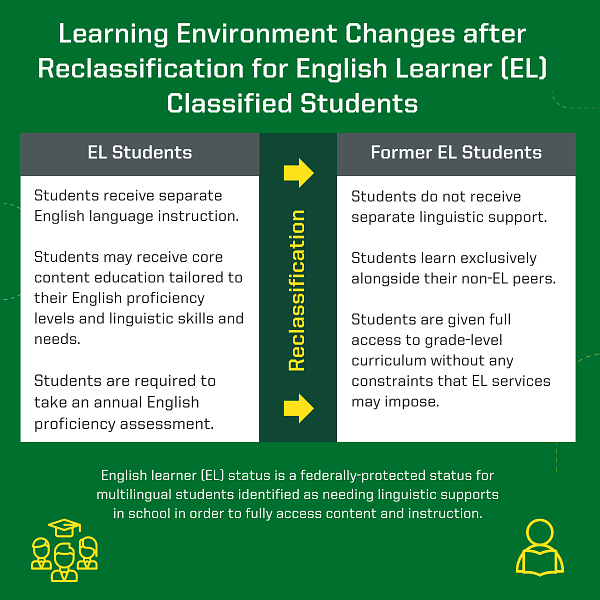Reclassification is a fresh start for English learner students
English learner (EL) status is a federally-protected status for multilingual students identified as needing linguistic supports in school to fully access content and instruction. When EL students pass a certain English proficiency assessment and meet other criteria required by states, they are considered “proficient” in English and the school removes their EL classification in a process called reclassification. Once reclassified, former EL students no longer receive specialized services. For example, they no longer receive separate English language instruction or core content tailored to their English proficiency levels and linguistic skills and needs. Instead, they learn exclusively alongside their non-EL peers. Therefore, for EL students, reclassification marks an important educational event that introduces changes in their learning environments.
Because of these instructional changes, a growing number of studies have examined how reclassification impacts students’ educational achievement and attainment. Removing linguistic supports might harm educational outcomes for students benefiting from specialized instruction. By contrast, exiting EL status may benefit students if they were being withheld from full access to grade-level curriculum as ELs. Indeed, existing studies have found a mix of positive, negative, and null effects of reclassification on students’ outcomes.
In order to understand the effects of exiting EL status holistically, our team of researchers from the University of Oregon and WestEd examined findings from these reclassification studies using meta-analysis. Our goal was ultimately to inform state and local policy decisions about EL reclassification. Specifically, we wanted to understand (1) how reclassification affects EL students’ English language arts (ELA) test scores, math scores, and likelihood of high school graduation, and (2) what factors influence the relationships between reclassification and these outcomes.
On average, reclassification does not impact students’ outcomes
Across studies, we found that on average, reclassification has small and statistically insignificant impacts on test scores and graduation rates. These results suggest that many students experience neither benefit nor harm when exiting EL status and its associated services. This null finding may be good news because it indicates that current reclassification policies and EL services may be supporting multilingual students’ smooth transition between learning environments.
Reclassification effects change over time
Some studies followed former EL students for several years after reclassification. By analyzing these studies, we found that students may experience an initial learning loss in the first year after reclassification, perhaps due to the shock of new instructional environments and the loss of language supports. However, we also found that students experience annual gains in subsequent years, potentially due to increased exposure to mainstream content. This change over time was salient for ELA test scores. This finding tells us that reclassification effects evolve as students adjust to curricular changes.

EL services influence reclassification effects
We also found that reclassification benefits students’ math test scores more in educational settings with bilingual programs. While more research is needed to understand this link, it is possible that students’ continued exposure to academic instruction in their home languages after reclassification smooths any shock that might otherwise have been harmful with the removal of English development supports. Alternatively, strong language skills developed through bilingual education may position former EL students for success with their instructional transition.
Patterns may differ by state and context
Across states, the size of the multilingual student population differs widely, as do the backgrounds and home languages of the population. California has one of the largest multilingual student populations in the country and, unsurprisingly, most of the studies examining reclassification effects were conducted in California. We found that there may be different trends in reclassification effects across states and districts, and particularly in California. For example, regarding changes in reclassification effects over time, we found both smaller initial losses and smaller later gains in California compared to other states. California also had unique reclassification effects for elementary students when compared to middle and high school. Because of California’s large historic multilingual population, policies and practices for both EL and former EL students may be different there compared to other parts of the country.
What can we learn from this study?
A wide range of reclassification policies and EL services are currently in place across the nation. While all states base reclassification decisions on students’ English language proficiency, some states also use additional criteria like course grades, academic test scores, or teacher recommendations. Likewise, districts and schools offer diverse services and instructional models to meet their obligation to support EL students’ access to appropriate instruction and content.
Our research found emerging evidence that states’ reclassification policies and practices are, on average, facilitating smooth instructional transitions for multilingual students. But we also found that initially, there may be an instructional shock as students lose access to specialized services, underscoring the need for appropriate supports for both EL and reclassified students, especially in the time leading up to and following reclassification. Supports such as bilingual programming may facilitate this transition. We hope to see more research examining reclassification not just as an administrative change for students but as a potentially influential educational transition. Further, we encourage research from a variety of states and educational settings to improve our understanding of reclassification and its role in supporting multilingual students’ experiences and successes in school.
By Taiyo Itoh, Doctoral Student, College of Education, and Ilana Umansky, PhD, Associate Professor, College of Education, University of Oregon.
Molly Faulkner-Bond, Lorna Porter, Ryan Lewis, and Emily Tanner-Smith contributed to data collection and analysis for this study.
HEDCO Institute Blog 11- April 30, 2024

